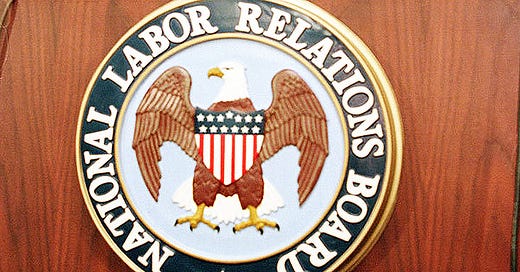Minority Unionism and the NLRB
The theory has never been accepted by the full Board, but it's largely untested before a Democratic majority.
On Monday morning, news broke that a group of 200-some Google employees had signed authorization cards with the CWA and officially formed the “Alphabet Workers Union.” The workers are apparently dubbing their labor organization a “minority” union, which will assumedly one day attempt to bargain on a members-only basis rather than seek majority representation of the firm’s hundreds of thousands of employees. There is a strong rationale for organizing under this method at a corporate giant rather than through the impossible strictures of the NLRA’s exclusive representation model, but it begs the question of what Google is obligated to do when presented with a request for bargaining.
Section 8(a)(5) of the National Labor Relations Act makes it unlawful for an employer to refuse to collectively bargain with “the representatives” of its employees, “subject to the provisions of Section 9(a).” Section 9(a) sets forth that representatives which have been designated or selected by a majority of employees in an appropriate bargaining unit will be the exclusive representative of all the employees in the unit for purposes of collective bargaining with the employer. The conventional understanding of the interplay between these provisions since the NLRA’s inception has been that the employer’s duty to bargain only attaches when facing a majority union, and unsurprisingly, the NLRB has never explicitly extended bargaining rights to a minority union. I believe this is so for three reasons: (1) the NLRA’s architects and its supporters spoke openly of the superiority of majority unionism in the workplace; (2) unions were strong enough for the first quarter-century of the Act’s existence that very few would have been explicitly seeking bargaining from a minority position; and (3) this interpretation of the provisions is, frankly, the more sensible reading on its surface.
This sentiment went largely unchallenged until 2004, when respected labor law professor Charles J. Morris published his book The Blue Eagle at Work. In it, Morris forcefully argued that the NLRA was never meant to restrict bargaining with minority unions. He demonstrated that neither the legislative history, NLRB case law, or any Supreme Court opinions explicitly forbade such bargaining, which it would have assumedly needed to do since such bargaining was commonplace pre-Wagner Act. The law can both prefer elections and majority representation without making these the sole means of bargaining. Moreover, Section 8(a)(5)’s mere mention of Section 9(a) does not tie the former to the latter; to Morris, it was there to reinforce Section 9(a)’s relation to the broad organizing rights granted to employees under Section 7.
However, Morris’ arguments have not found mainstream acceptance outside of the academy. The United Steelworkers organized a minority union at Dick’s Sporting Goods in 2006 and cited The Blue Eagle at Work as authority to the Labor Board in support of its refusal-to-bargain charge. The George W. Bush-appointed-General Counsel’s office issued an Advice Memo rejecting Morris’ reasoning and commanded dismissal of the Section 8(a)(5) charge, relying on the mountains of legislative history and case law which sang the praises of exclusive representation as the best harbinger of industrial peace. More damningly, the Memo singled out an attempt by some legislators to explicitly include minority unionism within the text of duty-to-bargain provision that failed to make it into the Wagner Act’s text.
But as Morris mentions, Congress also rejected language that would have explicitly restricted minority unionism from the duty to bargain. This ambiguity in the final product suggests that the Labor Board could use its administrative expertise to forge a path of its own in interpreting national labor policy (and reverse path when it saw fit). It thus does not necessarily contradict Morris’ argument to point to statements favoring majority unionism over minority unionism, as the NLRB is free to favor exclusive representation while still allowing other avenues under the law. Indeed, the overwhelming difficulty in organizing unions under the majority model would support a reasoned relaxation in doctrine.
There is reason to believe that Morris’ Blue Eagle may finally fly under the Biden Board. In one of his last written opinions before his term expired, Democratic Board Member Kent Hirozawa wrote a concurrence in 2016 that expressed approval of expanding the conventional understanding of Sections 8(a)(5) and 9(a) to apply to minority unions. Hirozawa, a union-side labor lawyer both before and after his stint with the Labor Board, fits the mold of what nominees Biden will be making to the agency in 2021. Assuming Hirozawa is not somehow a lone wolf on this issue among Democratic appointees, his concurrence could very well become the majority opinion by the time Google’s union were to be pushing its rights before the NLRB.
I would not be surprised if the Alphabet Workers Union, sensing a soft underbelly in the law, timed their announcement to line up with Biden’s inauguration. I am agnostic regarding Morris’ broader policy arguments that minority unionism is a potential salvation for the American labor movement, but I support attempts to expand collective bargaining rights to more workers than the precious few who presently possess them under prevailing jurisprudence.





If the Board favors majority unionism it could clean up the process to increase the liklihood of more elections and more bargaining in cases where unions win elections.
Brandon,,, can you please call the inspector general of the NLRB,,, David P. Berry @ 202-273-1960 and asked him about case number 16-CA-174370 16-CA-180656 16-CB-239578
Thank You in Advance... HELP HELP HELP